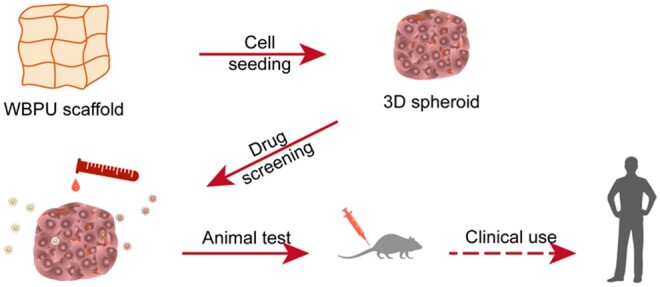- Record: found
- Abstract: found
- Article: found
Polyurethane scaffold-based 3D lung cancer model recapitulates in vivo tumor biological behavior for nanoparticulate drug screening

Read this article at
Abstract
Lung cancer is the leading cause of cancer mortality worldwide. Preclinical studies in lung cancer hold the promise of screening for effective antitumor agents, but mechanistic studies and drug discovery based on 2D cell models have a high failure rate in getting to the clinic. Thus, there is an urgent need to explore more reliable and effective in vitro lung cancer models. Here, we prepared a series of three-dimensional (3D) waterborne biodegradable polyurethane (WBPU) scaffolds as substrates to establish biomimetic tumor models in vitro. These 3D WBPU scaffolds were porous and could absorb large amounts of free water, facilitating the exchange of substances (nutrients and metabolic waste) and cell growth. The scaffolds at wet state could simulate the mechanics (elastic modulus ∼1.9 kPa) and morphology (porous structures) of lung tissue and exhibit good biocompatibility. A549 lung cancer cells showed adherent growth pattern and rapidly formed 3D spheroids on WBPU scaffolds. Our results showed that the scaffold-based 3D lung cancer model promoted the expression of anti-apoptotic and epithelial–mesenchymal transition-related genes, giving it a more moderate growth and adhesion pattern compared to 2D cells. In addition, WBPU scaffold-established 3D lung cancer model revealed a closer expression of proteins to in vivo tumor, including tumor stem cell markers, cell proliferation, apoptosis, invasion and tumor resistance proteins. Based on these features, we further demonstrated that the 3D lung cancer model established by the WBPU scaffold was very similar to the in vivo tumor in terms of both resistance and tolerance to nanoparticulate drugs. Taken together, WBPU scaffold-based lung cancer model could better mimic the growth, microenvironment and drug response of tumor in vivo. This emerging 3D culture system holds promise to shorten the formulation cycle of individualized treatments and reduce the use of animals while providing valid research data for clinical trials.
Graphical abstract
Related collections
Most cited references42
- Record: found
- Abstract: found
- Article: not found
Global Cancer Statistics 2018: GLOBOCAN Estimates of Incidence and Mortality Worldwide for 36 Cancers in 185 Countries
- Record: found
- Abstract: found
- Article: not found
